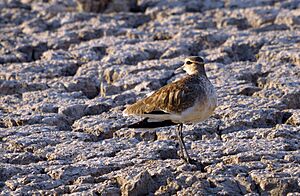Sociable lapwing facts for kids
Quick facts for kids Sociable lapwing |
|
|---|---|
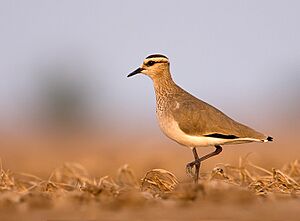 |
|
| At the Little Rann of Kutch, India | |
| Conservation status | |
| Scientific classification | |
| Genus: |
Vanellus
|
| Species: |
gregarius
|
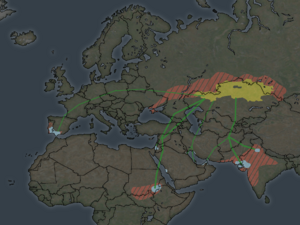 |
|
| Range of V. gregarius (Compiled by: BirdLife International and Handbook of the Birds of the World (2019) 2019.) Breeding summer range Migration overwintering Contracted range (extirpated) | |
| Synonyms | |
|
Chaetusia gregaria (unjustified emendation) |
|
The sociable lapwing (Vanellus gregarius) is a type of bird called a wader, belonging to the plover family. In the UK, it's also known as the sociable plover. These birds travel long distances, breeding in Kazakhstan and spending their winters in places like the Middle East, Indian Subcontinent, and Sudan. Long ago, people sometimes called this bird the Black-bellied lapwing.
Contents
What is a Sociable Lapwing?
The sociable lapwing is a medium-sized bird. It has long, black legs and a short, black beak. These birds are known for their striking looks.
How to Identify a Sociable Lapwing
When it's not breeding season, the sociable lapwing has light brown wings. Its head has a very clear pattern. It has a black crown on its head and a black stripe across its eye. White lines border this eye stripe. The bird's belly is white.
In flight, you can easily spot it. It has long black legs and a white tail with a black band at the end. Its wings show a mix of brown, white, and grey colors.
Changes in Summer Plumage
During the summer breeding season, the bird's colors become much brighter. Its brown feathers turn greyish and slightly shiny. The cheeks, however, stay an ochre (yellow-brown) color. The stripes across the eyes and the crown become darker. The lower part of the bird's chest turns black. This black color fades into rich chestnut-colored feathers closer to its tail.
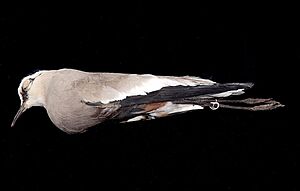
Young sociable lapwings look a bit different. Their back feathers have borders, which makes them look "scaly." They only have faint hints of the head pattern seen in adult birds.
Sociable Lapwing vs. White-tailed Lapwing
The sociable lapwing looks similar to the white-tailed lapwing. However, there are key differences. The sociable lapwing has a striped crown and dark grey legs. The white-tailed lapwing has a plain head and yellow legs.
Sociable lapwings are about 27 to 30 centimeters (10.6 to 11.8 inches) long. Their call is a harsh sound, like kereck.
Where Do Sociable Lapwings Live?
Sociable lapwings prefer dry grasslands and open fields. They also live in cultivated areas. This is different from other lapwings, which often like wetter places near water.
Breeding Grounds
These birds breed in the steppes of Kazakhstan. A steppe is a large area of flat, treeless grassland. The female bird lays three to four eggs in a nest on the ground.
Migration Routes
Historically, sociable lapwings used two main migration paths:
- Western Route: They flew over Central Asia and Turkey. They would then spend winter in Israel, Palestine, Lebanon, parts of Saudi Arabia, and Eastern Africa.
- Eastern Route: They traveled to coastal Iran, the United Arab Emirates, and India for the winter.
New Migration Route
Something interesting happened in Qatar and Kuwait. These countries used to only see sociable lapwings by accident. But as these nations developed, more farms and parks were built. Since the early 2000s, sociable lapwings have started visiting these areas often. Some even stay for the winter. This has created a new, third migration route through the center.
European Sightings
The sociable lapwing used to live in many parts of Europe. Now, it's almost gone from the continent. A small group from Ukraine migrates to the Iberian Peninsula. Only a few birds might spend winter there. On their journey, these birds have been seen in almost every European country. They are often found with Northern lapwings during migration.
What Do They Eat?
Sociable lapwings eat in a similar way to other lapwings. They pick up insects and other small prey. They mostly find their food in grasslands or on farmland.
Status and Conservation
It has always been hard to count the exact number of sociable lapwings. Experts believed their population was declining. A big drop happened in the late 1900s. This left the current population at only 20-25% of what it used to be.
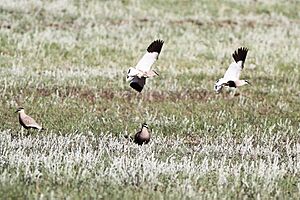
Recent Discoveries
Thanks to many years of studies, we now have better estimates. In October 2007, a very large group of about 3,200 sociable lapwings was found in Turkey. This was reported by Guven Eken, who directs the Turkish Nature Association. Also, 1,500 sociable lapwings were found spending winter in Syria.
The total population is now thought to be around 17,000 birds. Before 2007, there were reports of more nests being found each year. It's hard to say if this was a real increase or just because more people were looking for nests. The area where sociable lapwings live has shrunk a lot. They once lived from Ukraine all the way to China.
Challenges for the Population
Even though more birds were found, studies also showed that adult birds don't live very long. This means the population is expected to keep declining. The exact reasons for the population crash are not fully known. However, hunting along their migration paths is believed to be a major threat.
Images for kids
-
A skin specimen of a male sociable lapwing collected in the Russian Empire, 1913
-
breeding individuals in Kazakhstan





